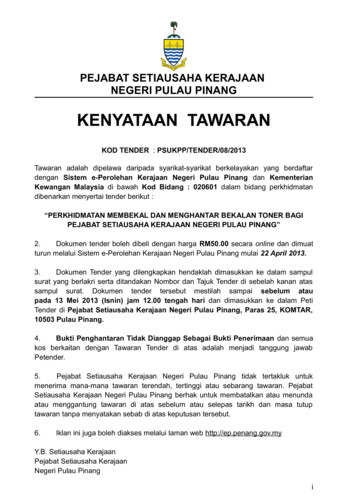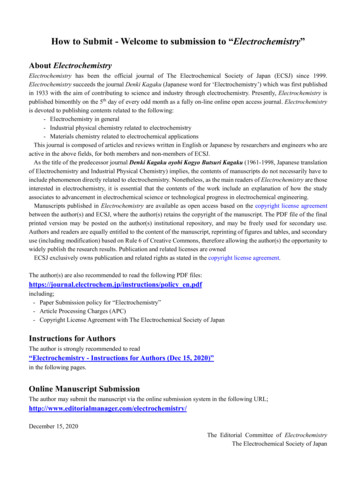Affordable HDR Conversion With SL-HDR1 Metadata
Affordable HDR Conversionwith SL-HDR1 MetadataA Cobalt Digital White PaperBy Ciro A. Noronha, Ph.D.High Dynamic Range (HDR) is an emerging technology that delivers noticeably better image qualitythan standard dynamic range (SDR) content with minimal bandwidth increase. However, while HDRcontinues to gain popularity, SDR needs to be preserved – at least for the near future – because alarge number of legacy consumer televisions do not support HDR. Acknowledging the mix of HDRand SDR devices in the marketplace, this white paper will examine different ways to provide costeffective, simultaneous service to both types of devices, and explain why the SL-HDR1 conversionoption is an ideal choice for broadcasters.Luminance and Wide Color GamutDynamic range is the ratio between thelowest and highest values of the luminance,or intensity of light emitted, from a display.Essentially, it is the ratio between the “whitestwhite” and “blackest black.” Conventional 8-bitdisplays, for example, have a dynamic range ofapproximately 100:1. Dynamic range is usuallyexpressed in stops, which is calculated asthe log base 2 of the ratio. So, 8-bit SDR has adynamic range of approximately six stops, whileprofessional 10-bit SDR offers approximately 10stops.
The human eye, however, can see about 1214 stops, which means it can perceive moredynamic range than offered by 10-bit SDRmaterial. So, how do you pack an HDR signalinto a 10-bit display? Thankfully, the humaneye is nonlinear in its response and perceivesmore detail at lower luminosities. HDR deliversimages with improved details by assigning bitsto light intensity in a nonlinear manner. Morebits are assigned to the lower intensities andfewer bits to the higher intensities to express ahigher range. Fundamentally, HDR shows moredetail in the bright areas.Light intensity is measured in candelas persquare meter (cd/m2), also known as nits. Astandard HDTV can produce luminance at about100 nits. A UHD LCD display can range from0.05 to 1,000 nits, while a UHD OLED monitorcan produce 0.0005 to 540 nits. In contrast,HDR can code up to 10,000 nits, which nocommercial monitor today can reproduce.The diagram above shows a representation of the full range of light the human eye is capable of seeing. HDR is ableto retain a greater range of light than SDR from capture to final distribution. Pictures are more vibrant and life-like tothe viewer, regardless of screen size.The luminance encoded in SDR signals isrelative – at 100 percent, it basically tells thedisplay to show its whitest white. In contrast,HDR codes the absolute value of the luminance,using a non-linear transfer function based onwhat the eye can perceive. This is the SMPTE2084 Perceptual Quantizer (PQ) transfer.Beyond luminance, HDR also features widecolor gamut (WCG), which has more colorinformation than standard HD signals. Theset of colors a signal uses or a display canshow is called the “color space.” There arethree defined color spaces in use today: ITU-RBT.709, which is considered the standard colorspace for HD; DCI-P3, which is the standard fordigital cinema; and ITU-R BT.2020, which is theUHDTV standard.No commercial monitor today can display thefull Rec. 2020 color space, but a UHDTV withHDR and WCG will show more than the entireRec. 709 color space and at least 90 percentof the DCI-P3 color space. But what happenswhen a display is fed an HDR signal it cannotdisplay because the luminance and/or color
The objective of dynamic metadata is the same,but it changes from frame to frame. Staticmetadata can be seen as sort of an averageover the content, while dynamic metadata istailored to each individual frame. This dynamicmetadata is one of the ways the various HDRstandards differ.HDR StandardsThis graph is a representation of the color gamut. Theorange triangle represents REC.709 or 35.9% coverage.The green triangle represents REC.2020 which is 75.8%coverage.are out of range? The monitor must createan image as close as possible to the originalsource material – and to help the monitordo this job, metadata may be included in thestream. Metadata helps the monitor adapt theabsolute luminance of the HDR signal to itscapabilities.Static Vs. Dynamic MetadataMetadata can be static or dynamic. Staticmetadata, as the name implies, is fixed forthe duration of the content, and provides only“general” information. The basis for staticmetadata is SMPTE 2086. When content iscreated, it is mastered on a reference displayby the director/colorist. The static metadatadescribes the characteristics of this masteringdisplay, so that the monitor currently playingit can best approximate the mastering displaybased on its capabilities. SMPTE 2086 staticmetadata includes parameters such as thecolor and luminance range of the masteringdisplay, the color space used, and the transfercharacteristics. SMPTE 2086 was augmentedby CTA to include additional parameters suchas the Maximum Content Light Level (so themonitor will know the “brightest” pixel in thecontent) and the Maximum Frame-AverageLight Level.There are a number of competing HDRstandards available today, and most of themprovide some support for simultaneous SDRand HDR support. From a high-level point ofview, they can be classified as static (usingstatic metadata or no metadata) and dynamic(using dynamic metadata).The baseline HDR support starts with theSMPTE 2084 PQ transfer function, using 10-bitor 12-bit samples. This is the basis for mostHDR standards, and by itself does not includeany support for SDR. The HDR10 standard issimply the combination of SMPTE 2084 with 10bit samples and SMPTE 2086 static metadata;this combination is also standardized in ATSCA/341.Static vs Dynamic MetadataStatic metadata provides only one metadata valuewhile dynamic metadata provides a different metadatavalue for each frame of video.
One interesting static HDR standard that isin wide use today is Hybrid Log-Gamma (HLG),which is not based on SMPTE 2084 PQ. It is anattempt to use a backward-compatible transfercurve that will “work” with both SDR and HDRmonitors without any metadata. At the lowluminance levels, it matches SDR, so an HLGsignal applied to an SDR monitor will “look OK”,which an HDR monitor will show the improvedranges at the higher luminance levels. HLGtrades off simplicity (same signal everywhere,no metadata processing) with quality (it is notas good as the dynamic metadata options).HLG is standardized in ARIB STD B-67, ITU-RBT.2100, and ATSC 3.0.The dynamic HDR standards all start from a PQbase layer, with metadata defined in ST 20941. The most relevant ones are SMPTE 209410 (Dolby Vision), SMPTE 2094-40 (HDR10 , adynamic version of HDR10), and SL-HDR1.HDR-to-SDR Conversion OptionsThe basic operation of various dynamicstandards can be understood as transmitting“an image plus instructions” that can beprocessed by a monitor. What varies is whatyou start from. In Dolby Vision and HDR10 , youstart with an HDR image, and the “instructions”allow the mapping of that HDR image to anymonitor, all the way down to an SDR monitor.While it is possible for an end device togenerate SDR from this HDR signal, that enddevice needs to understand and process themetadata in order to do so.With SL-HDR1, the opposite happens. Whatis transmitted is a standard SDR signal, andthe metadata allows a compatible device toreconstruct the original HDR signal (or anyintermediate level suitable for its capabilities).This is the ideal way to support legacy SDRdevices – they will just ignore the metadata(because they do not support it) and simplydisplay the SDR image. This is conceptually thesame as what was done when analog color TVwas introduced. The signal was the standardblack-and-white content, with the colorinformation added “on the side”. A black-andwhite TV would understand the signal and showthe black-and-white version, while a newercolor TV would extract the color informationand show a color picture.To support a mix of SDR and HDR devices,broadcasters have several options. First issimply simulcasting two or more versions ofthe same signal, one in HDR and one in SDR.Simulcast is well suited for OTT distribution,where multiple versions of the same contentare already required. It is also the onlyreal solution for supporting legacy 8-bitdevices, such as AVC 4:2:0 decoders, becauseHDR requires 10-bit performance to avoidposterization.HLG is another option, as the same signal iscompatible with both HDR and SDR. However,this can negatively impact the quality of theSL-HDR1 WorkflowSource: ETSI TS 103 433-1The SL-HDR1 workflow allows for simultaneous HDR and SDR delivery with just a single SDR output with metadatafrom the encoder. A downstream receiver determines HDR or SDR playout.
HDR signal, unless the distributor controls theproduction. Other dynamic modes transmit HDRwith metadata that can be used to reconstructSDR, but it requires a receiving device thatunderstands HDR and metadata.A better choice is SL-HDR1, which transmits avery good quality SDR signal with metadata toreconstruct the HDR image – and automaticallydelivers a full HDR experience to compatiblemonitors and/or set-top boxes. SL-HDR1 isdefined in ETSI TS 103 433-1, and was approvedin early 2018 as an amendment to ATSC A/341.Metadata is carried through inside the videoelementary streams as SEI messages incompressed streams (H.264/H.265), or carriedin the VANC using SMPTE 2108 for SDI.For scalable HEVC (SHVC), the A/341 standardcalls for two spatial layers – base andenhancement – and the SL-HDR1 metadatamay be included in either layer. The spatialresolution of the enhancement layer is upto three times that of the base layer. If theSL-HDR1 metadata is in the base layer, itapplies to both layers, but if it is present inthe enhancement layer, it applies only to it.This gives the flexibility to the broadcaster tohave different signal levels. For example, theycan broadcast a free SDR base layer at lowerresolution, and add a premium HDR layer athigher resolution.Case Study: Spectrum NetworksSpectrum Networks was able to ingest both HDR and SDR feeds with a single cost-effective truck, while providingviewers with both high quality HDR and SDR content.The viability of SL-HDR1 conversion was provenin Summer 2017, when Spectrum Networksproduced and broadcast a Los Angeles Dodgershome baseball game in HDR for MLB Network.All SDR sources were upconverted to HDR. AnSDR downconversion was used to check theSDR feed. The production generated HDR andSDR versions simultaneously using a singleproduction environment, distributing SDR,SL-HDR1, and HDR10 (converted from SL-HDR1)versions to audiences.Since then, SL-HDR1 processing continues tobe used to produce live sports production.It was used successfully by AT&T to deliver4K HDR imagery of its live coverage of “MLBNetwork Showcase” games. NBC Sports Groupalso delivered all seven home games of theNotre Dame Fighting Irish football team’s2018 season in 4K HDR for AT&T’s DirecTVsubscribers. The football games were producedon site in 1080p, and upconverted live to 4KHDR.
The Cobalt SolutionsCentral to these productions is a workflow builtaround Cobalt Digital’s flagship 9904-UDX-4Kup/down/cross converter and image processorfor openGear frames. Rather than hireseparate trucks for HDR and SDR productionsof the same event, the 9904 can be used toconvert SDR material to HDR (using a processcalled “Inverse Tone Mapping”) in real-time.This way, the whole production chain can be inHDR. The processing card uses the TechnicolorHDR Intelligent Tone Management (ITM)software to provide this mapping function.The Technicolor technology defines how theavailable dynamic range is used, managingbrighter lights and darker shadows to deliversharper, more realistic images.For HDR output formats, the 9904 supportsHLG, Sony S-LOG3, and PQ10, with 4K resolutionsupport via 12G or quad 3G inputs. HDMI 2.0output is also available with HDR InfoFramesupport for monitoring. It can also apply anarbitrary static 3D LUT to a signal for formatconversion, color space conversion, or staticITM. The 9904 is compatible with PomfortLiveGrade and Wowow WonderLook on-set lookmanagement software.Other Cobalt card-based products that canbe part of the SL-HDR1 workflow include the9223 3G/HD/SD MPEG-4 encoder series, whichsupports legacy 8-bit, 4:2:0 SDR devices. The9992-ENC encoder supports H.264/H.265 8-bitand 10-bit applications, with resolutions up to4Kp60.Case Study: Spectrum Networks - Cobalt ProductsCobalt Digital Inc. designs and manufactures award-winning edge devices that help liveCobaltDigital tandhelp livevideoproductionandmasterandcontrolclients transitionto IP, 4K,HDR,the tiontoIP,4K,HDR,thecloud,andbeyond. As a founding partner in the openGear initiative and proud member of SMPTE,beyond.Asoffersa foundingpartner in theopenGear initiativememberof SMPTE,Cobaltalsoa implifiestechnologicalCobalt alsooffers a stechnologicaladoption.Distributedthrough a worldwidenetwork rs,andother partners, Cobalt Digital products are backed with a five-year warranty.other partners, Cobalt Digital products are backed with a five-year M 2019 COBALT DIGITAL INC 2019 COBALT DIGITAL INC
HDR codes the absolute value of the luminance, using a non-linear transfer function based on what the eye can perceive. This is the SMPTE 2084 Perceptual Quantizer (PQ) transfer. Beyond luminance, HDR also features wide color gamut (WCG), which has more color information than standard HD signals. The set of colors a signal uses or a display can
Images HDR et rendu HDR Images HDR Rendu HDR Définitions Principes Comparaison avec les images classiques Construction des images HDR Logiciels Formats. Historique Utilisation des images HDR pour le rendu 3D Intérêt du rendu HDR Limitations Solutions pour l'affichage.
by the HDR technology which is a combination of High Dynamic Range, Wide Color Gamut and Higher Bit-depth (10/12-bit sampling). HDR components[10] are shown in Figure 2-1. HDR improves the pixels and enables viewer to see a more realistic image and have an immersive visual experience. Figure 2-1 Component of HDR technology
The Atlona AT-HDR-H2H-88MA is an 8 8 HDMI matrix switcher for high dynamic range (HDR) formats. It is HDCP 2.2 compliant and supports 4K/UHD video @ 60 Hz with 4:4:4 chroma sampling, as well as HDMI data rates up to 18 Gbps. The AT-HDR-H2H-88MA is ideal for professional HDMI signal rout
brightness and contrast on a TV to produce a more realistic image. Brightness: A normal TV puts out around 100 - 300 "nits" of brightness. An HDR TV can in theory produce up to 5,000 nits. Note: Generally TVs that claim to be HDR or "HDR compatible" may be able to only play HDR content, but not have full HDR picture quality.
High Dynamic Range (HDR) and Wide Color Gamut (WCG) can have a big positive impact on a viewer by creating a more convincing and compelling sense of light than has ever before been possible in television. A recent scientific study1 with professional-quality Standard Dynamic Range (SDR) and HDR videos found that viewers prefer HDR over SDR
Download Software 4 Add new License 4 Help Center 5 3. Activating SilverFast HDR 7 4. SilverFast HDR as demo 8 . tif, jpg 2000 and psd. The following data formats are supported in 24 bit: tif, jpg 2000, pdf and psd. HDR (Studio) is also able to read . as PDF files by clicking Download in the Dow
HDR will develop a fully styled mockup of the website based on BCWMC’s branding and feedback provided by BCWMC on the style examples sent by HDR. BCWMC will review the design mockup and provide edits, which HDR will incorporate. The final schematic and mockup
Application of Silicon Carbide in Abrasive Water Jet Machining Ahsan Ali Khan and Mohammad Yeakub Ali International Islamic University Malaysia Malaysia 1. Introduction Silicon carbide (SiC) is a compound consisting of silicon and carbon. It is also known as carborundum. SiC is used as an abrasive ma terial after it was mass produced in 1893. The credit of mass production of SiC goes to Ed .























